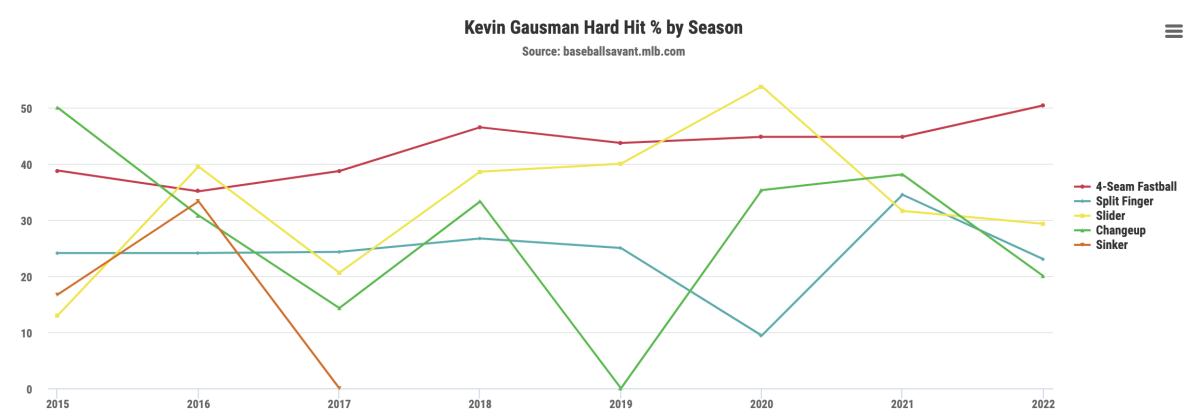Heater Highlight: On Kevin Gausman's Fastball

DUNEDIN, FL— Kevin Gausman's splitter makes batters look silly. They whiff over it, chase below the zone, and walk back to the dugout in shame. But, if you ask Gausman, the heat is just as important.
Gausman threw his four-seam fastball 48% of the time last year—more than his splitter—earning high whiffs, called strikes, and setting up his tumbling split. It's a crucial part of his repertoire, but it's also the pitch opponents hit hard in 2022.
Much has been made about Gausman's .364 batting average on balls in play (BABIP) against last year, and the many horseshoes he must've misplaced to earn that rotten batted-ball luck. And yes, some of it certainly was groundballs through shifts and unlucky singles. But, Gausman's '22 BABIP was also driven by a career-worst 50.4% hard-hit rate on his four-seamer, the fourth-highest mark among MLB starters. Opponents hit just .192 against his split, but they knocked his fastball for a .333 average.
Even with the scorched four-seamers, Gausman was one of the best in baseball last year, earning a Cy Young vote and posting the second-best FIP among qualified starters. The splitter plays—always has—but it's the four-seam fastball where most of his 'pitching' takes place.

Gausman’s fastball is one of the best set-up pitches in baseball. It comes off the same plane as his splitter and throwing it at the top of the zone draws batters in, to whiff at the off-speed later in at-bats and games.
He's trying to put the heater at the top or above the zone about 60-70% of the time, the 32-year-old said. With about an inch of perceived rise, Gausman's fastball draws unproductive swings on unhittably high fastballs, when his command is on. When Gausman had to hit during his National League days, he got a taste of the high-heat technique, seeing just how enticing those fastballs above the zone looked from the box.
"It's one thing that helped me and made me realize how good pitching up in the zone is," Gausman said.
Baseball fiends have probably heard the 'if it's high let it fly, if it's low let it go' approach to hitting knuckleballs, and some teams seemingly tried to employ the approach against Gausman's split last year. The Minnesota Twins, for example, seemed locked in during a June Gausman start, cashing five runs (three earned) and chasing the righty after 3.2 innings. Minnesota hitters swung at 37 of his 56 fastballs (66%) but just seven of his 21 splits (33.3%). For context, Gausman's average swing rate on his split was 60.6% last year.
The approach is easier planned than executed, Gausman said, and teams' success against his heater can be as much about his control than opposing team's 'figuring him out'.
“They can say 50-50,” Gausman said. “But they still got to flip the coin, right?”
Kevin Gausman, 96mph Fastball and 86mph Splitter, Overlay pic.twitter.com/LPezWDeb5T
— Rob Friedman (@PitchingNinja) September 15, 2022
But, it's also why pushing the fastball above the zone and out of danger is so important for Gausman, as teams are taking their rips (at least trying) against the high heat. On fastballs just above the strike zone, exit velocities against Gausman last year were the lowest of any quadrants, but when they leak into the zone, things get hit hard. Obviously, he has to throw in the zone sometimes, or batters will never swing, so Gausman got a few more four-seam tricks to keep hitters off balance.
One club in Gausman's bag is the low fastball. It may not induce the whiffs and mediocre contact that four-seams above the zone draw, but Gausman's found he can sneak heaters low for strikes, especially later in games. Because of the same release point as his splitter, opposing hitters confuse the low strike as a split set to tumble well below the zone.
“Sometimes you'll see me early in the game throwing a fastball up and later in the game throwing a fastball down,” Gausman said. “If I've got really good command that day, [I can] kind of steal some strikeouts.”
Another tool he uses to keep opposing hitters off the heat is mixing up velocities on his fastball. Last year, Gausman hucked in four-seamers that ranged anywhere from 89.2 to 98.7 MPH. The velo variations “create a whole other pitch” the righty said, and the numbers agree. On all Gausman fastballs, opponents hit .333 last year. But, counter-intuitively, they hit .214 on heaters under 93 MPH.
Most importantly, Gausman's edge comes from getting ahead. When Gausman gets. an early strike, his chase rates jump on all deliveries. Pitching is a constant chess match, or bowhunting as Gausman calls it. When the pitcher dictates the terms, it's his game to lose.
Sometimes, the batter wins and drives a fastball. But most of the time, Gausman sends them back to the dugout.
